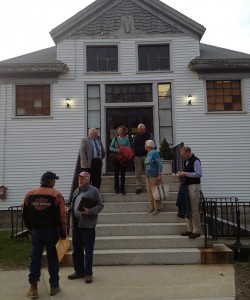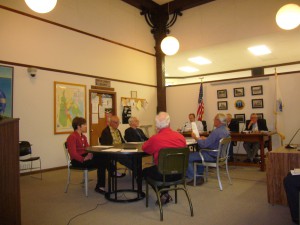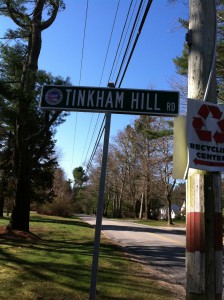With Jennifer Francis sitting squarely between the Planning Board and dozens of Marion residents for the duration of the proceedings, Tuesday’s public hearing on Marion’s proposed solar bylaw crackled with an energy of its own.
The bylaw – which formalizes the process for installing residential solar arrays in Marion, while also recommending a Municipal Solar Overlay District – is currently slated for a vote at the May 13 Town Meeting after the Board of Selectmen signed off on the warrant in March. But its fate is in question amid a prolonged disagreement between the Planning Board and the Energy Management Committee on language, provisions and protocols.
Tensions between the boards continued on Tuesday, while community input appeared to steer members toward compromise by meeting’s end. The public hearing was the first of a scheduled three this week.
“There has been a rapid increase of solar energy capacity in our state, and that’s something to be proud of,” Francis said while making a 10-minute opening presentation. “This bylaw is designed to protect Marion’s character, provide oversight and offer guidelines for solar energy collection.”
Francis cited Massachusetts General Law 40A – which prohibits municipalities from disallowing residential solar installations unless they threaten the “public health, safety or welfare” – in arguing that Marion needs a bylaw without “onerous demands.” She said that residents currently interpret the absence of a bylaw to mean that they may not install arrays, which is not the case.
“If this bylaw had been in place, we probably would not be in this situation,” said Francis, invoking an ongoing lawsuit against the town involving a denied residential solar installation.
The proposed bylaw outlines prerequisites for solar installation in Marion that include one acre of land, a limit of 120 percent of current energy use eligible for collection, 600-square-foot- and 900-square-foot limits on arrays depending on system type, a 35-foot setback and screening.
But the Planning Board made clear that those prerequisites are not enough.
Member Ted North, the Board’s staunchest opponent of the bylaw, expressed skepticism with the state’s jurisdiction, rattling off 14 towns in Massachusetts – several nearby, including Bourne and Dartmouth – where residential solar installations have been disallowed, or are allowed only in overlay districts or with special permits.
“That doesn’t mean,” Francis responded, “they won’t face litigation in the future.”
Chairman Jay Ryder insisted on stricter controls for residents planning ground-mounted systems, namely a special permit process.
“A special permit requirement is a very key issue,” he said. “Without it, we can’t support your bylaw.”
Various Planning Board members said that neighboring property devaluation with potentially unsightly arrays – even with a screening requirement – is their primary concern.
Residents Jerry “Rico” Ferrari, who is running for an open Planning Board seat in the May 17 election, and Jan Keeler agreed.
“Will I have any say?” Ferrari asked. “Does it take away my right to comment? I don’t want to give up my right. There are too many rights being given up today.”
“They’re not going to gather more sun down there,” said Keeler, pointing to the floor. “Why would anyone want to look at them?”
Francis pointed out that residents living on lots smaller than one acre would have to apply for a special permit, while some roofs are not facing a direction allowing for sufficient solar collection.
Former Marion Planning Board member Margie Baldwin said she supports the solar bylaw.
“I don’t know if my neighbor likes looking at my swimming pool, but it’s there,” she said. “It’s time for Marion to move ahead on alternative energy. I know it’s not perfect, but nothing’s perfect. You’re picking at very small points here.”
Marion resident Kathy Reed said the parties should proceed with caution.
“I think both the Planning Board and the Energy Management Committee want to see a bylaw,” she said. “But this is an issue of taking power of decision from the Planning Board. I’m not saying no, I just have a big concern that my interests be protected by people I voted to elect.”
Ryder said that the Board is exercising due diligence, while the EMC is moving too quickly.
“This procedure takes longer than the EMC is giving it,” he said, at one point suggesting that presentation at a fall Town Meeting would be more appropriate. “I feel very strongly that you need that time and we need that time.”
EMC member Norm Hills disagreed.
“We’ve been at this for 11 months, and nine months have been in conjunction with you guys,” he said.
Reprising a confrontation from an April 1 meeting, Ryder snapped back at Hills.
“Don’t go there, Norm,” he said. “The EMC went off on their own and developed this bylaw. We had an agreement that we would develop this bylaw together, and that didn’t happen.”
Given the split opinion in the Town House Conference Room – even Beaumont Solar President and CEO Phillip Cavallo, who had earlier been chastised by a Marion resident for commenting as a representative from a company in New Bedford, came out in support of a broadened special permit to “get it right” – Francis seized the opportunity to offer a compromise. She asked if a special permit amendment to the bylaw for all residential solar installations would satisfy the Planning Board. The response was favorable, and the public hearing will continue on Wednesday at 7:00 pm.
Though the meeting is taking place too late for this week’s print edition of The Wanderer, readers can find our ongoing coverage online at www.wanderer.com. In addition, there is another public hearing scheduled for Thursday, April 18, 7:00 pm.
By Shawn Badgley


